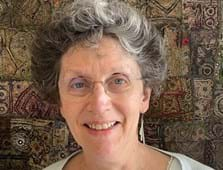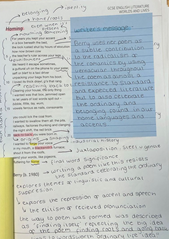In the light of very serious concerns about GCSE English among teachers and the wider subject communities, as well as many students, University English has set up a small, informal working group to explore the problems and consider what a serious reform of the English qualifications might look like. I was asked to join the group. It includes teachers, academics and people involved in ITT. Among others in the group, I was keen that we should have a shared sense of the history, of how we have arrived at the current situation – what came before and what has changed. I agreed to do a short background paper for our first meeting. We have yet to meet and hopefully some really fruitful ideas and a broad consensus for change will emerge.
In the meantime, this historical overview of changes to 16+ qualifications might be of broader interest to English teachers, so I’m publishing it as a blog. A few caveats… I haven’t been able to fill in all the detail and there are almost certainly gaps. Some reading this may well have personal memories, research knowledge, or knowledge from the chalkface to add to it. It’s also worth saying that I’m aware that among the facts in the timeline – this happened, on this date – there are also comments that express my personal opinion on these facts. These are, of course, open to debate and critique.
It was supposed to be 1 side of A4 but has turned out to be rather longer! It starts with a very helpful short section by the brilliant academic and expert on English in education, John Hodgson. I’ve lifted this verbatim from an email he sent me when I asked for any background he might have. What follows after that is a timeline of 16+ examination and National Curriculum key events. Finally, I’ve listed some issues that I thought the working group might want to address – it’s not exhaustive, the issues overlap, and there may be plenty more for us to discuss.
A big thank you to Gary Snapper for reading, commenting and making suggestions along the way and to John Hodgson for his invaluable advice.
The development of the idea of ‘Subject English’ as we now know it
English education as we understand it derives from the ideas and practices discussed at the Dartmouth conference of 1966 (held in USA). UK participants at Dartmouth represented both "London" and “Cambridge" English, and over the succeeding 25 years there was broad agreement on certain principles.
- English was a unitary subject comprising both "language" and “literature" studies. Indeed, it connected with the Humanities, Social Studies and Arts curriculum. The Stenhouse Humanities Curriculum Project of the 1970s facilitated cooperative work between English and humanities departments. Leavis had always claimed that English led out into other subjects, and in 1980 Pete Medway wrote that English had embraced the whole curriculum.
- Both language and literature studies should connect with students’ life and cultural experiences and help them to reflect on and articulate these.
- Literary response should be personal and authentic. This view was based on I.A. Richards’ experiments with practical criticism and Leavis’ insistence that a response was “personal” or nothing.
- The usefulness of teaching & learning formal grammar was in debate, but initiatives such as Peter Doughty’s Language in Use and Keith Davidson’s London O level language paper demonstrated that language study could be interesting and important.
- The literature curriculum should include texts from outside the UK and could include texts in translation.
- Students should see themselves as writers. Literature assignments could include rewriting texts for a different purpose and reader.
- As English involved reflection rather than factual recall, coursework was an appropriate method of assessment for much of the curriculum.
- There was relatively little input from HE into the school curriculum. The 1970s cultural turn in HE English was taken up by some A level teachers but didn’t significantly inflect the curriculum framework.
John Hodgson
1960s
Different regional Awarding Bodies offered a range of O Level and A Level exams. These were not nationally regulated. There was no agreed set of subject criteria. Regional Boards tended to attract students from that region – JMB, London, Cambridge.
1962
The introduction of a ground-breaking 100% internal assessment English Language O Level, spearheaded by the JMB, an Awarding Body based in Manchester. It was argued for, and heavily supported by teachers themselves. Coursework assessment, for CSE, GCSE and A Level was internally and externally moderated. The moderation process offered one of the most important and effective forms of teacher CPD available. New teachers developed an understanding of what students should be aiming for, and there were regular department discussions to agree standards and think about how best to achieve high quality work.
1965
The introduction of CSEs as an alternative to O Level. O Level had always been seen as only catering for the top 20% of the ability range and there was a grass roots demand for something appropriate for children in secondary modern schools, certifying their achievements and allowing them to progress on. There were 3 ‘modes’ of CSE, with varying patterns of assessment. Mode 3 was 100% coursework, marked by the school. This allowed teachers lots of scope for the inclusion of a very wide range of diverse texts alongside canonical ones. Students who achieved Grade 1 CSE were deemed to have the equivalent of an O Level and could progress on into A Level and other qualifications. Many did. One problem was that CSE students couldn’t go above a Grade C at O Level and many students at the bottom end of O Level simply failed rather than getting credit for their achievements.
1970s
This was a period when accountability broadly meant accountability to parents and students, and to the local inspectorate, who knew the schools they worked with and provided support alongside critique. The downside may have been a lack of national consistency in standards but the upside was a flowering of teacher-led initiatives, including significant work on anti-racist English teaching, the introduction of a wide range of texts representing the cultures of students taught and the valuing of their own language and cultures. This was true of 16+ exam courses as well as KS3. Coursework folders reflected this diversity.
1973
The school-leaving age was raised to 16, meaning that a lot more students needed a leaving qualification, so there was a big increase in CSE entries. There was continuing concern about a split system, lack of equality of esteem and so on. But CSEs did allow for progression for many students. CSE Mode 3 and the coursework only O Level were moderated and in an era of proportionate accountability (via the local inspectorate), teachers took seriously their professional duty to give reliable, valid judgements. Many students did not achieve the critical Grade 1 for CSE or the O Level pass. This did not impact on the teachers or school, other than parents, governing body, SLT seeking to ensure that the school was doing the best it could for its cohort.
(This was also the year when the AEB 753 Level English Literature was introduced, later becoming the very popular AEB 660. It allowed 50% coursework.)
1980s
The Government became impatient with what it saw as progressive developments that neglected ‘standard English’, grammar teaching and seemed not to pay enough respect to the canon (this despite the fact that many canonical authors were consistently taught). They launched three enquiries – Cox, Kingman and LINC (Language in the National Curriculum) over this period, to try to address this. None of the reports came to conclusions that matched the government’s intentions and LINC was actively suppressed, despite spawning a huge amount of high quality work on knowledge about language (KAL) up and down the country, with lots of grassroots work and enthusiasm among teachers. All three enquiries drew in a large number of experts and practitioners from all levels – academics, school leaders, classroom teachers, policy makers.
1988
The Introduction of GCSEs, replacing CSE and O Level as a single unified exam for all. English GCSE was 100% coursework. Students assembled a portfolio of extended writing of various kinds – some for literature, some for language – including critical essays, creative responses to literature, original creative writing, book reviews, work on media texts and language topics.
In approving the introduction of GCSE, Sir Keith Joseph insisted on close involvement. There was the first development of a national set of general and subject-specific criteria (approved by Joseph himself). There was also a requirement for tiered papers. The idea was to show ‘positive achievement’ rather than ‘degrees of failure’.
This was the birth of Subject Criteria – subject aims, grade criteria etc. Some of us were involved in creating these for GCSE and A Level, working with QCA, and with later iterations, with QCDA (both now abolished). In the early stages, they were seen mainly as ‘describing’ the core elements of the subject – a force for getting more consistency and mapping the core elements of the subjects – but very soon they became translated into the criteria for assessment. This, for me, is where the rot set in. While they were really useful ways of describing elements of language or literary study, the minute that specifications had to be written to assess them, they became atomised, and the content of the specifications were distorted to fit the AOs. When you then added into the mix the accountability measures for success at GCSE and A Level, the Assessment Objectives (AOs) quickly became a rod for teachers and students’ backs, not a useful description of the broad aspects of language or literary study.
1988-89
The first statutory National Curriculum was introduced, with Programmes of Study for first teaching in September 1989. GCSEs were tied into the National Curriculum. It’s worth remembering this. Any change to the National Curriculum had knock-on effects and any major future changes would require changes to the NC. There was considerable argument and debate in this first iteration and future ones about the way in which canon/non-canonical texts were defined and included (or not), for instance over terms like ‘other cultures’, ‘different cultures’ and so on. (I wrote a TES piece on this complaining about the inclusion of Jackie Kay and other British black writers in ‘other cultures’. Why not ‘our’ culture?)
1991
The Conservative government under John Major made the first moves to reduce the amount of coursework. Major initially called for 20% but was forced to settle for 30%. A similar set of arguments about coursework took place over A Level, with subject experts, NATE, EMC and others arguing the case for English needing it because of the nature of the subject.
1992
First publication of schools’ league tables.
1994
The A* grade was introduced, because of concerns about the A grade having suffered from grade inflation.
1995
New updated National Curriculum (after the Dearing Report).
1999
New National Curriculum for first teaching Sept 2000 (David Blunkett, Labour Secretary of State for Education).
2000
Curriculum reform of A Level. Introduction of AS as standalone qualification and staging post towards A Level. Known as ‘Curriculum 2000’.
From around 2005 many schools started teaching the iGCSE as a course, with fewer hurdles to jump, and seen as more likely to produce good results. It freed schools from some of the complications and unpalatable elements in the GCSE.
2008
New National Curriculum (Ed Balls, Labour Secretary of State for Education).
2010
GCSE specifications for 3 English subjects: English, English Language and English Literature. Students took either English or both of the other two. This meant that students were channelled in different directions according to attainment.
GCSE coursework was replaced by Controlled Assessment (CA) (60% for English and English Language – 40% written, 20% speaking and listening).
First application of the Ebacc in League Tables.
2010s
Modularity of GCSEs was removed (2012) and the ability to resit elements, or resit a whole examination in a January series was lost for first assessment in 2014. All elements had to be sat at once, and reported on in the same series. Michael Gove’s reforms included banning iGCSE from use in English schools because they were seen as an easier route and way of avoiding the specific elements that the government wanted to promote in the national GCSE system.
2013
New National Curriculum for first teaching Sept 2014 (Michael Gove, Conservative Secretary of State for Education).
2015
New A Level specifications introduced (with max 20% CW). English had to argue the case for any continuation of coursework. Teachers generally were highly supportive of A Level coursework at this point.
AS became a standalone qualification only – a return to linearity.
Tiering was abolished for most GCSE subjects, so no more Foundation or Higher Tier entries. This was coupled with major changes to the Subject Criteria, which made the English Language specification in particular a real challenge for a large number of students. The new GCSE specifications had no coursework or Controlled Assessment, no American texts, no ‘ephemeral’ texts such as blogs, web material, newspaper articles etc.
Loss of coursework/CA meant the loss of the ‘spoken language study’, a much-loved requirement for knowledge about language as part of GCSE, with a language investigation. Brilliant work was done on this by teachers and students & it was a great bridge from GCSE to A Level English Language and advert for it.
In Literature GCSE, there was a new requirement for a full pre-twentieth century novel. American texts were banned, taking Of Mice and Men and Arthur Miller plays out of KS4 English. Awarding Bodies chose to put different elements of the new requirements in different examining slots. The impact of AQA’s decisions has been huge, given their share of the GCSE market. For instance, their decision to examine pre-20th century non-fiction in the English Language GCSE has been highly problematic. Their decision to ask different questions on language and structure in English Language has cemented a very unhelpful atomisation of these elements of textual study and a set of practices that could be described as ‘examination English’ rather than conventional ‘English studies’. The loss of coursework has led to creative writing only being assessed in examinations. Spoken language has been downgraded – it is reported on but no longer counts towards the final grade.
Since 2015
There has been stagnation, with no major changes. This has solidified the qualification into something that teachers regard as ‘normal’, though recent surveys by EMC and NATE suggest many are very dissatisfied with it. New teachers are coming into the profession who were taught this GCSE and now teach it themselves. The one recent change has been the welcome introduction of some new text options into the OCR and AQA GCSEs, with a new and more diverse poetry cluster and new novel and drama texts for AQA, as part of decolonising the curriculum. These are very much to be welcomed, though it will be interesting to see how confident teachers feel about switching from texts that are heavily resourced and planned for. The poetry anthology looks like the most likely focus for a popular change.
Some big questions for the working group to consider
- Should English Language and English Literature be separate subjects?
- If not, if English Literature is studied by all students, should English Language still be heavily focused on literary texts?
- Should English Language include, once again, elements of critical literacy and focus on texts in the world, and online, as well as books?
- What’s the place of pre-twentieth century texts in a GCSE English or English Literature qualification?
- How far should English Literature be ‘English’ literature? How much emphasis on the canon? On decolonising literary study?
- What role should speaking and listening have in a GCSE English qualification? (Language and/or Literature)?
- Are there arguments for re-instating some element of coursework/work of the course/portfolio/teacher assessment?
- How much should the curriculum be nationally determined? How much teacher choice and/or student choice should there be?
- Are the current ways of examining fit for purpose? E.g. split short questions on language and structure in Eng Lang; essays and paragraphs rather than other forms of critical writing; creative writing as an exam task and a vehicle for assessing literacy; no spoken assessment etc.
- Are there historic elements to 16+ examinations that have been lost, that might offer a better approach e.g. summary, desk studies, essay titles for argument writing, extended essays in coursework etc.
- How can GCSE capitalise more on thriving elements in the literary lives of adults and young adults e.g. poetry and performance, contemporary fiction, gaming, language in film, TV and within the media etc.
- Is there a place for serious language study (KAL) in an English Language GCSE qualification?
- Is there a place for media study in an English Language GCSE qualification?
- In the light of the above, is there a formulation of subject ‘English’ (single/double/integrated or not) that we can agree on, that might include some (or all?) of the following and possibly others: ‘language', 'culture', 'literature' 'media' 'textuality', 'interpretation', 'rhetoric', 'communication', 'critical literacy', ‘creative writing/writing for personal growth’, ‘competence/literacy for adult life’, ‘oracy’, ‘reading for pleasure’, ‘cross-cultural understandings’ and so on.




